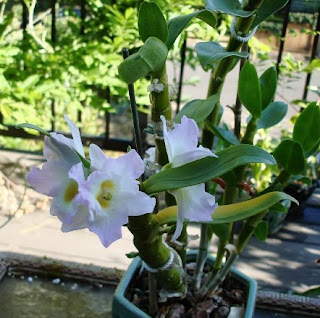Still learning about orchids, and watching their progress over the past year. It's been about that long since I started becoming more interested in them.
The way I look at it, the first part is to not-kill them. The second part is to get them to grow. The 3rd part is to get them to bloom. Propagation is optional, but fun. If purchased in-bloom, another aspect of the first part is to keep them blooming as long as possible. That seems to be rather easy.

This unlabeled
Paphiopedilum hybrid, Maudiae type, was one of the first that I obtained. I need to check - I think it's a green flowered type. Should be back in the links (labels). I've been treating it as the books instruct, medium light, general orchid plant food weakly weekly. It added a couple of new growths. I count the leaves, thinking that if a growth reaches 5 or 6 leaves, it will be time to bloom. Not certain it that's true, but last week I noted the appearance of a bud. Cool!

Close-up of the bud. Another may be headed there as well, I'll add it if it really is a flower bud. I understand that the process from bud to blossom is gradual, and patience is needed. The upside of that slow process, is that once in bloom, the flowers can last a month or more. Regardless, I'm excited!

The books and the Yamamoto website (see prior posts) promote a season of coolness in bright light to promote
Dendrobium nobile hybrid blooming. These are under eaves (out of the rain) south side of house (bright light). One can hardly call the light here in the Pacific Northwest "direct sunlight" so I'm not concerned about sunburn, and anyway these plants were in full unfiltered sun all summer long. This treatment, allowing coolness at night and not soaking them, keeping them in bright light, is considered key to obtaining nice flowers on these hybrids.

Of course, this NOID
Dendrobium nobile hybrid continues to cheerfully violate the rules, blooming and blooming and blooming. It is indoors in a south exposure, but spent the summer in the same location as the others.
 Dendrobium phaelenopsis
Dendrobium phaelenopsis "Genting" obtained last month at Missouri Botanical Gardens in St. Louis, after traveling to midwest for my dad's funeral. It continues to bloom cheerfully. I'll hold off any repotting until it finishes blooming.

This Cymbidium has been in a full-sun exposure, all summer. I generally gave it "weekly weakly" feeding, but on occasion provided some higher nitrogen plant food, because most instructions suggest higher nitrogen in summer. I'm keeping it outside for cool nights, per standard instructions for this genus.

Here's the question now - Is this a flower bud? Or another growth spurt. Watchful waiting!

Now we get to "the problem with impulse buying". Last year I bought this plant on impulse at a big box store. It was in a tiny plastic bag. The label is below.

I didn't know anything about Vandas or Ascoscendas at the time. Both are probably inappropriate for this setting and my house, needing more light than I can provide.

Instructions not too helpful either. Can't even tell, is it an Ascocenda or a Vanda? Peobably should throw it away, space is valuable. But, it stays alive, growing slowly, so I'll keep it for now.
 A couple dozen fell off with the heavy rains the past few days. They taste very 'peachy' although not super sweet. There are also about 2 dozen left on the tree. Cool!
A couple dozen fell off with the heavy rains the past few days. They taste very 'peachy' although not super sweet. There are also about 2 dozen left on the tree. Cool! Tomatoes continue to produce. The heavy rains caused splitting of the cherry tomatoes, and a few big tomatoes. The Better Boys have given us some humongous juicy tomatoey tomatoes, and the others have done well, as well. "Fourth of July", while not producing until mid august, has been quite rewarding with plum-sized juicy fruits.
Tomatoes continue to produce. The heavy rains caused splitting of the cherry tomatoes, and a few big tomatoes. The Better Boys have given us some humongous juicy tomatoey tomatoes, and the others have done well, as well. "Fourth of July", while not producing until mid august, has been quite rewarding with plum-sized juicy fruits. This is very late for a chive crop. These gave enough for a big batch of chive-filled dumplings.
This is very late for a chive crop. These gave enough for a big batch of chive-filled dumplings.
























